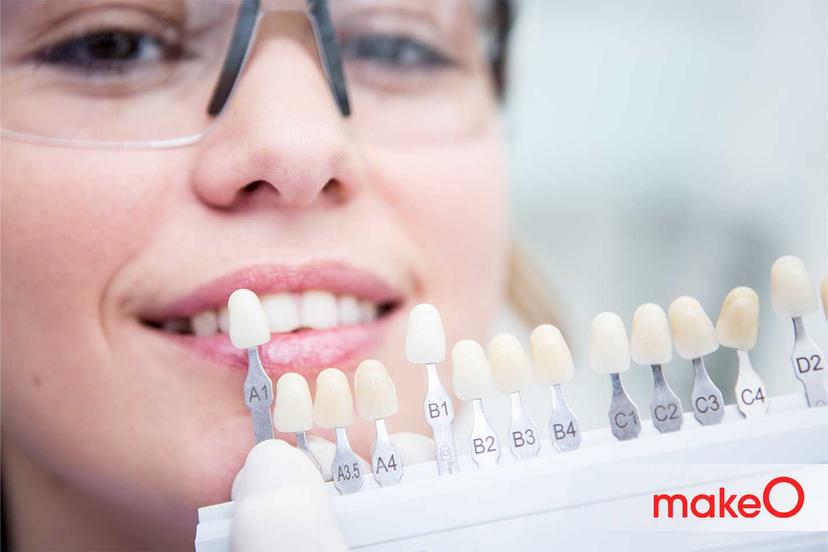MakeO blog
What is Calculus Bridge
A calculus bridge refers to a thick, hardened layer of dental calculus (tartar) which is formed over multiple teeth, mainly accumulating along the gum line. Dental calculus is widespread, affecting around 90% of the general population. Initially yellowish, tartar darkens over time and becomes much harder to remove. If left untreated, it can irritate the gums and cause gum disease, inflammation, and bone loss.
A calculus bridge not only affects oral hygiene and health but also provides a rough surface for bacteria to thrive, further damaging your teeth and gums. In this blog, let us explore how a calculus bridge is formed and its impact on oral health.
How is a Calculus bridge formed?
Dental calculus tartar is a type of tartar buildup that connects two teeth, and it forms when plaque is not removed properly and hardens over time.
The process of forming a calculus bridge starts when bacteria attach to the surface of your teeth. The bacteria stick using tiny hair-like structures called pili. Once attached, the bacteria start forming colonies and create a sticky biofilm called plaque.
Over time, plaque combines with minerals in the saliva, causing it to harden into tartar (calculus). Eventually, the tartar build-up fills the teeth gaps and forms a bridge-like deposit connecting two or more teeth. This bridge not only makes your teeth look yellow and rough but also creates a surface for more bacteria to grow. If the tartar is not removed, it can lead to gum disease and other problems like tooth decay or bad breath.
Several factors contribute to the growth of plaque and tartar. Poor oral hygiene, like inadequate brushing or flossing, sugary diets, smoking, wearing braces, dry mouth (xerostomia)and even crooked teeth can negatively impact oral hygiene and promote calculus formation.
Oral health effects of having Calculus
Due to the calculus bridge, teeth can face several oral health issues, affecting both the appearance and health of your teeth and gums. These include:
- Visible stains: Yellow, brown, or black stains indicate tartar buildup. -** Bad breath**: Tartar can cause persistent bad breath, creating discomfort in social situations.
- Gingivitis: Red, swollen, or bleeding gums occur due to irritation caused by tartar.
- Tooth damage: Tartar erodes enamel, making teeth more vulnerable to cavities.
- Gum recession: Prolonged tartar can cause gums to pull away from teeth.
- Serious health risks: Gum disease bacteria can enter the bloodstream, leading to heart infections and affecting conditions like diabetes.
Managing calculus in the teeth is crucial to protect both your oral and overall health.
How to prevent calculus bridge
To prevent tartar buildup and protect your teeth from problems like cavities and gum disease, follow these simple tips:
Brush your teeth consistently: You need to brush twice a day with a toothbrush which has soft bristles and use fluoride toothpaste to clean all surfaces and along your gums.
Floss every day: Make sure to floss every day to get rid of plaque and food remnants stuck between your teeth.
Use mouthwash: Rinse twice daily with an alcohol-free, antibacterial mouthwash to reduce bacteria.
Avoid tobacco: Tobacco products increase tartar buildup and gum disease risk.
Consider anti-calculus products: There are specialised toothpaste and mouthwashes containing anti-calculus agents such as pyrophosphate, zinc salts, and bisphosphonates that help inhibit tartar formation. These products work by preventing plaque from hardening into tartar and can help control calculus buildup.
Address teeth alignment issues: Teeth misalignment can make cleaning difficult resulting in plaque formation, leading to tartar buildup. Consider invisible braces and explore invisible braces price options for an affordable solution to maintain oral health.
Visit your dentist regularly: Regular professional cleanings help remove tartar missed during brushing.
By following these practices, you can keep your teeth clean and healthy while reducing the risk of tartar buildup.
Conclusion
A calculus bridge forms when plaque hardens into tartar, which can lead to gum disease, cavities, and other oral health issues if left untreated. Regular brushing, flossing, mouthwash use, and professional dental visits are essential for preventing tartar buildup. In addition, correcting misalignment of teeth using invisible braces or aligners can help maintain proper oral hygiene. By following these simple steps, you can maintain healthy teeth and gums while reducing the risk of a calculus bridge and associated complications.
FAQs
How to remove tartar from teeth? Tartar can be removed by a dentist through a professional dental cleaning. A dentist will use specialised tools to carefully remove tartar and prevent future oral problems.
How to remove hardened plaque from teeth? Hardened plaque otherwise called calculus can be removed from your teeth by a dentist using professional tools. Regular brushing and flossing help prevent plaque buildup before it hardens.
How to remove calculus from teeth? Calculus (tartar) is too hard to be removed at home. Only a dental professional can effectively remove calculus using specialised tools. How to remove tartar from teeth without a dentist?
While only a dentist can remove tartar, regular brushing with a tartar-control toothpaste can be tried. Proper brushing and daily flossing, using an antibacterial mouthwash, and consuming a healthy diet help prevent plaque buildup, reducing the risk of tartar formation.
How to remove plaque from teeth at home? Brush twice a day with fluoride toothpaste, floss daily, and use mouthwash to help remove plaque. Regular dental check-ups are also important for professional cleaning.
related categories
Related articles

Types of Braces: Removable vs Fixed Braces, Which is Right For You?

This Diwali, Smile Bright With makeO Teeth Whitening Kit

Dr. Pravin Shetty: Pioneer in Lingual Orthodontics & Innovative Smile Solutions
How do I Know I’m the Right Candidate for makeO toothsi Teeth Aligners?


